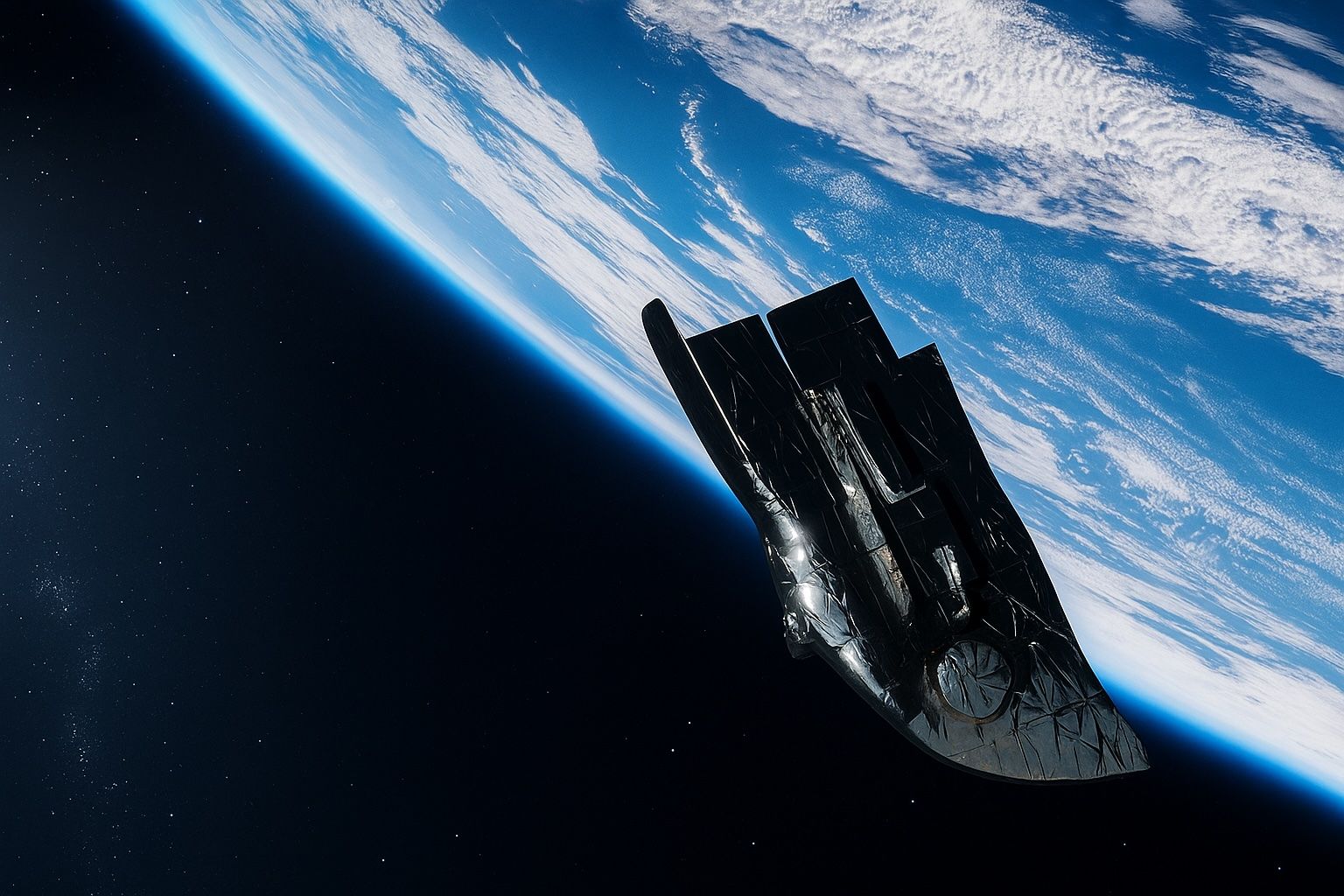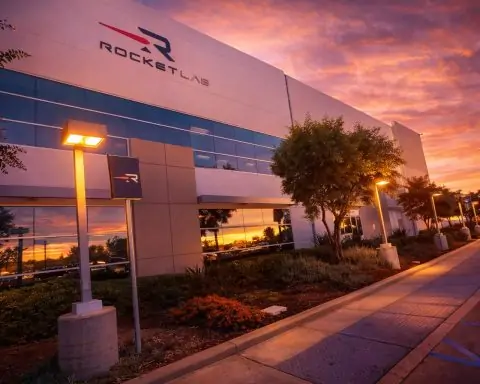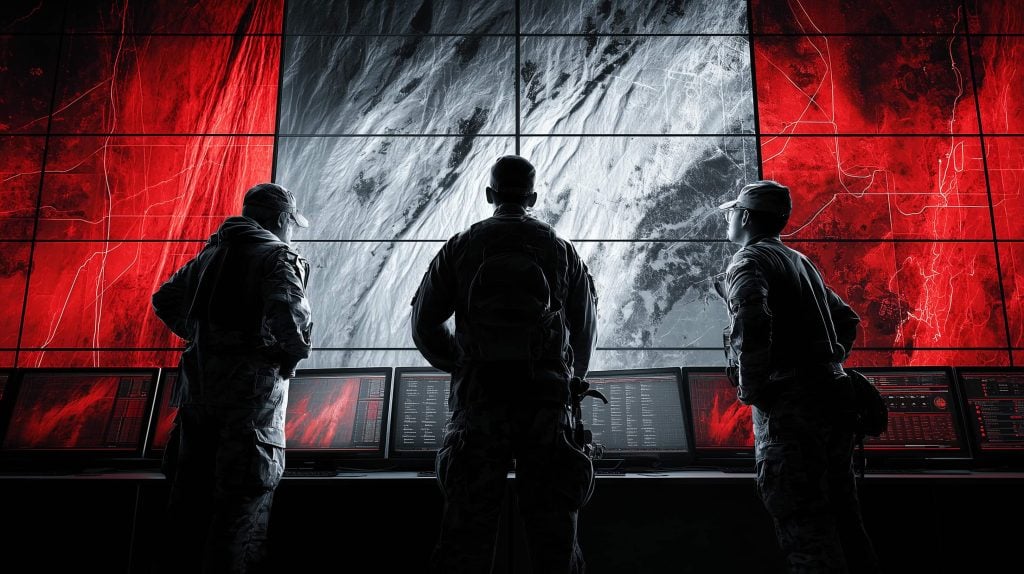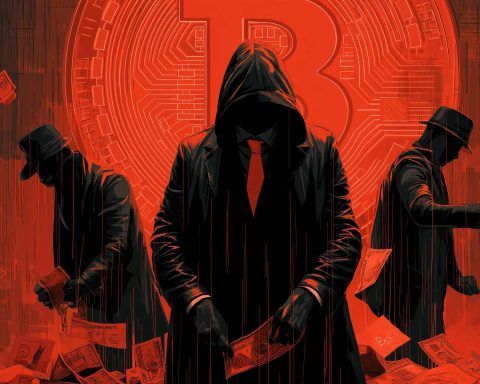- The Black Knight legend links Nikola Tesla’s 1899 reports of periodic radio signals from Colorado Springs to the idea of an ancient satellite in Earth orbit.
- In 1927 Jørgen Hals observed long-delayed echoes, and in 1973 Duncan Lunan claimed a star map pointing to Epsilon Boötes suggesting a 13,000-year-old alien probe, later retracting parts of the interpretation.
- In 1954 Donald Keyhoe asserted the Air Force had detected two unknown satellites, a claim with little evidence and likely a publicity stunt.
- In February 1960 the U.S. military detected an unidentified dark object in polar orbit, later identified as Discoverer 8 debris from the CORONA program.
- In 1963 Mercury astronaut Gordon Cooper reportedly saw a glowing object, but transcripts show he did not report seeing a spacecraft; he later was a UFO believer in other contexts.
- By the 1970s the term “Black Knight” emerged to describe the alleged ancient satellite, with the name possibly borrowed from the UK Black Knight rocket program.
- During NASA’s STS-88 mission in December 1998, astronauts photographed a dark object, which NASA explained as a lost thermal insulation blanket from the ISS assembly.
- James Oberg and other NASA engineers publicly debunk the 1998 images, confirming the object was space debris and that no evidence supports an alien craft.
- Duncan Lunan clarified that his 1973 analysis was not a claim about an orbiting 13,000-year-old satellite and that he does not endorse the Black Knight conspiracy.
- In 2020 astronomers identified a new Earth mini-moon that turned out to be a spent 1960s rocket stage, illustrating mundane explanations for apparent anomalies in orbit.
The Black Knight satellite conspiracy theory alleges that a mysterious object of extraterrestrial origin has been orbiting Earth for thousands of years, monitoring humanity. Over decades, this legend has woven together disparate events – from Nikola Tesla’s early radio experiments to NASA space shuttle photographs – into a single narrative. Despite scientific debunking and official explanations, the Black Knight story refuses to fade, thriving in UFO circles, tabloid media, and internet lore. This report presents a neutral, in-depth look at the Black Knight satellite legend, covering its origins, supposed evidence, notable figures involved, media/pop culture references, and the scientific counterarguments and official explanations that address the claims.
Origins and Historical Timeline of the Black Knight Legend
The Black Knight myth did not arise all at once; it evolved by retroactively connecting several unrelated incidents across the 20th century. Key milestones in its purported timeline include:
- 1899 – Tesla’s Mysterious Signals: Famed inventor Nikola Tesla reported detecting unusual repetitive radio signals during experiments in Colorado Springs. Tesla speculated these signals might be intelligent in origin – possibly attempts at communication from Mars [1] [2]. (Modern scientists suggest Tesla likely intercepted natural radio sources or man-made interference, but conspiracy believers retrospectively link this to the Black Knight.) Tesla never claimed to hear an Earth-orbiting satellite, yet some insist he was unknowingly receiving transmissions from the Black Knight [3] [4].
- 1920s – Long-Delayed Radio Echoes: In 1927, Jørgen Hals, an amateur radio operator in Norway, observed long-delayed echoes (LDEs) – radio signals that mysteriously echoed back several seconds after transmission [5]. These eerie repeats had no clear explanation and fascinated scientists. Decades later, in 1973, Scottish researcher Duncan Lunan re-examined old LDE data and claimed to find a pattern. By plotting echo delays, Lunan said he discovered what looked like a star map pointing to the star Epsilon Boötes, implying the echoes were messages from an alien probe in orbit for 13,000 years [6] [7]. Notably, Lunan himself did not name this hypothetical object “Black Knight,” nor insist his idea was fact – he eventually retracted parts of his interpretation as “unscientific” [8]. Nonetheless, later storytellers folded Lunan’s speculative 13,000-year-old probe into the Black Knight mythology.
- 1954 – “Two Satellites” Rumors: During the Cold War space race paranoia, U.S. UFO researcher Donald Keyhoe told newspapers that the Air Force had detected two unknown satellites orbiting Earth [9] – at a time (1954) when no country had launched any satellite (Sputnik would not launch until 1957). Major media like the San Francisco Examiner and St. Louis Post-Dispatch ran these claims [10] [11]. Keyhoe, who was promoting a UFO book, offered no proof and many suspect the story was a publicity stunt [12]. Nevertheless, the idea of mysterious “man-made moons” above Earth entered the public imagination.
- February 1960 – Unknown Dark Object in Orbit: The U.S. military’s detection of an unidentified “dark object” in polar orbit made headlines and is another pillar of the Black Knight legend. TIME magazine reported that the U.S. Navy had spotted what was thought to be a stray Soviet satellite [13]. This spurred concern since neither the U.S. nor USSR admitted owning such an object, especially in a polar orbit (which allows coverage of the entire Earth). Shortly after, however, the U.S. Department of Defense revealed the truth: it was debris from the Discoverer 8 satellite, part of the secret CORONA spy satellite program [14] [15]. In other words, the “mystery satellite” was actually a lost piece of an American reconnaissance mission – not a 13,000-year-old alien craft. (Discoverer 8 had malfunctioned, and a component had entered an unexpected orbit.) This official explanation was published in TIME’s follow-up, but Black Knight enthusiasts often ignore or downplay it [16].
- 1963 – Gordon Cooper’s Space Sightings: Another oft-cited story involves Mercury astronaut Gordon Cooper. During his 1963 Faith 7 orbital mission, Cooper allegedly reported seeing a glowing green object ahead of his capsule, and supposedly the tracking station picked up an unidentified object. Black Knight believers have latched onto this as a “sighting” of the alien satellite. However, Cooper himself debunked this: transcripts and his accounts show he never reported encountering a spacecraft on that mission [17] [18]. (Cooper was an outspoken believer in UFOs in other instances, which likely made this rumor more alluring.) In reality, there is no evidence from NASA records that Cooper saw the Black Knight during Mercury 9.
- 1970s – The “Black Knight” Name Emerges: By the 1970s, the various threads (Tesla’s signals, Hals’ echoes, mysterious orbiters, etc.) began to be woven together in UFO lore. The term “Black Knight” started appearing to describe this supposed ancient satellite. The origin of the name itself is uncertain – it did not come from Tesla or the early reports, and may have simply been a dramatic nickname adopted in later years [19]. (Coincidentally, the UK had a rocket program in the 1960s named Black Knight used for testing missile re-entry vehicles, but that project was unrelated and never put any actual satellite into orbit [20] [21].)
- 1998 – STS-88 Space Shuttle Photos: The modern resurgence of the Black Knight conspiracy came with a series of intriguing NASA photographs. During the Space Shuttle Endeavour’s STS-88 mission (the first mission to the International Space Station in December 1998), astronauts photographed a dark, irregularly shaped object floating in low Earth orbit [22]. These images – showing a black object silhouetted against Earth’s atmosphere – went public on NASA’s website and immediately fueled wild speculation in UFO and conspiracy communities [23]. Enthusiasts claimed this was finally photographic proof of the Black Knight satellite that had been orbiting Earth for millennia. As the images spread online, the legend took on new life (more on these photos and their explanation below).
Each of these events was originally unrelated. Only through years of speculation were they stitched into a single narrative. As a senior astronomer quipped, “Black Knight is a jumble of completely unrelated stories … chopped up, stirred together and stewed on the internet to one rambling and inconsistent dollop of myth.” [24] In the sections below, we examine the alleged evidence behind this myth, who has been involved, how it’s been portrayed in media and pop culture, and what scientists and official sources say is really going on.
Alleged Photographic and Radio Evidence
Proponents of the Black Knight conspiracy cobble together various pieces of evidence – primarily unusual radio signals and perplexing images – to argue that an ancient alien satellite exists.
- Mysterious Radio Signals: The legend’s foundation lies in unexplained radio phenomena. Black Knight lore credits Nikola Tesla’s 1899 signal detections as the satellite’s first known transmission. Tesla wrote of receiving “periodic” signals suggesting numbered sequences, which he interpreted as possible messages from intelligent beings on Mars [25] [26]. Today, scientists find it far more plausible he intercepted natural cosmic radio bursts or background noise. In fact, no artificial radio source was known in 1899; the first confirmed extraterrestrial radio source (the center of our galaxy) wasn’t detected until the 1930s [27]. If Tesla truly picked up a signal, modern experts suggest it was “most likely from Earth”, not a satellite [28] [29]. Another radio case came in 1928, when Jørgen Hals observed long-delayed echoes of his own transmissions bouncing back after several seconds [30]. Conspiracy theorists postulate these LDEs were replies from the Black Knight. However, long-delayed echoes are a known (if still not fully understood) atmospheric/ionospheric phenomenon; there’s no specific evidence linking them to an alien object. Even Duncan Lunan’s famous 1973 interpretation proposing an alien probe was a speculative thought experiment, not a verified fact – and Lunan himself has distanced his work from the “Black Knight” theory [31] [32].
- Early Satellite Observations: Beyond radio waves, believers point to mid-20th-century reports of unidentified objects in orbit. The Keyhoe claims in 1954 of “two unknown satellites” and the 1960 detection of a dark orbiting object (mentioned earlier) are held up as proof that something was up there before humanity’s first satellites. However, scrutiny shows these claims had prosaic explanations or lacked evidence. Keyhoe’s story appears to have been a sensationalized news piece while he was promoting a book [33]. And the 1960 object, as noted, was identified as American space junk (not acknowledged publicly at first due to its military nature) – specifically a fragment of a Discoverer spy satellite that had gone astray [34] [35]. In short, no “unknown alien craft” was ever confirmed by those early observations, only misidentified human-made objects.
- NASA’s 1998 Photographic Evidence: The most compelling “evidence” cited for the Black Knight is visual. Photographs from Space Shuttle mission STS-88 in 1998 show a black object floating against the backdrop of Earth [36]. These high-resolution images (one of which is shown below) captured the imagination of the public and are endlessly reproduced in conspiracy articles and videos. UFO enthusiasts argue the object’s odd, asymmetrical shape and dark color suggest an ancient alien satellite, finally caught on camera. NASA, however, has a far more mundane explanation: during that mission (which was assembling the ISS), astronauts were installing thermal insulation covers on the station module. One of these thermal blankets slipped loose and drifted away from astronaut Jerry Ross during a spacewalk [37] [38]. The crew actually noted the loss in their logs – “Jerry, one of the thermal covers got away from you,” Mission Commander Robert Cabana radioed as the item floated off into space [39]. The lost blanket (also called a trunnion pin cover) was photographed as it slowly tumbled, sunlight making it appear black against the Earth’s surface [40] [41]. NASA tracked this piece of debris (cataloging it as object 025570) and confirmed it re-entered Earth’s atmosphere and burned up after about a week in orbit [42] [43]. In other words, the famed “Black Knight photo” depicts nothing more than a stray piece of space insulation – an unfortunate accident of the mission, not a millennium-old spacecraft. Astronaut Jerry Ross later even remarked that the conspiracy theories spun from that lost blanket are “a waste of valuable brain power” [44].
A 1998 NASA shuttle photograph often claimed to show the “Black Knight” object orbiting Earth. In reality, astronauts on mission STS-88 lost a thermal blanket during an ISS spacewalk, and this strange-looking debris was captured on camera [45] [46]. The object was officially cataloged and it burned up in the atmosphere a few days later, but the images sparked a viral legend.
In sum, none of the evidence presented – neither the enigmatic radio echoes nor the intriguing images – definitively indicates an ancient alien satellite. Each has an alternate (terrestrial) explanation. Nonetheless, believers argue that the combination of these anomalies, across decades, points to the presence of an otherworldly monitor in orbit. This belief has been bolstered by various individuals and even some space-related figures over time, as discussed next.
Notable Individuals and Space Agencies Involved
Several high-profile names and institutions have been roped into the Black Knight satellite narrative, either as purported witnesses, inadvertent contributors, or debunkers. Here are some of the key players often mentioned:
- Nikola Tesla (Inventor, 1856–1943): Tesla’s experimental radio work is considered the starting point of the legend. In 1899 he picked up unusual signals which he took as possibly intelligent [47]. Although Tesla spoke of communication from Mars (and his ideas were dismissed by contemporaries as speculative), Black Knight lore retroactively casts Tesla as the first human to detect the supposed alien satellite. Tesla never claimed an orbiting source, and scientists today suggest his “signals from Mars” were likely natural phenomena, not aliens [48] [49].
- Donald Keyhoe (UFO Researcher): A retired U.S. Marine Corps major, Keyhoe became a prominent UFO author in the 1950s. In 1954 he told press outlets that the Air Force was tracking two unknown satellites in Earth orbit [50] [51]. This startling claim gave the Black Knight story early momentum. However, no evidence or official confirmation ever surfaced. Many skeptics note the news stories were tongue-in-cheek or promotional [52] – Keyhoe had a history of sensational UFO claims while marketing his books. Still, his assertions planted the idea of alien machines in orbit years before Sputnik, making him a foundational figure in Black Knight lore.
- NASA and the Space Shuttle Program: NASA is central to the modern legend, mainly due to the STS-88 incident. In conspiracy narratives, NASA is often accused of “covering up” the Black Knight’s existence [53]. The reality is that NASA publicly released the 1998 photos and has consistently identified the object as a lost thermal blanket, not an alien craft [54] [55]. Astronauts involved (Jerry Ross and mission commander Robert Cabana) have openly discussed the lost blanket. Far from hiding the object, NASA even cataloged it and noted its re-entry. Additionally, NASA’s engineers and historians – notably James Oberg (a former shuttle engineer) – have invested effort in debunking the Black Knight claims. Oberg, who worked on the STS-88 mission team, interviewed the crew and showed step-by-step how the blanket was lost and how the myth grew from misinterpretation [56] [57]. In short, NASA’s role has been to provide prosaic explanations and transparency about space debris, even as conspiracy theorists insist NASA is hiding the “truth.”
- U.S. Military and Space Surveillance: Though not as frequently highlighted by name, organizations like the U.S. Air Force and Navy appear in the Black Knight story. The Navy’s detection of the 1960 object (Discoverer 8 debris) and the Air Force’s early satellite tracking efforts come up as evidence of suspicious objects in orbit [58]. The Air Force’s Space Surveillance Network today tracks thousands of pieces of orbital debris; any large unknown satellite – if one existed – would likely be cataloged as well. In fact, the 1998 shuttle blanket was cataloged by the U.S. Space Surveillance system [59]. Officially, neither the military nor any space agency has ever found an alien satellite orbiting Earth. During the Cold War, false alarms and unidentified radar blips occurred, but they were eventually attributed to known objects or sensor errors. The British rocket program named “Black Knight” (1950s–60s) is an often-cited red herring – apart from the spooky name, it had no relation to any alien satellite and never orbited a payload [60] [61].
- Astronaut Gordon Cooper: Cooper’s supposed encounter with the Black Knight during his 1963 Mercury flight is frequently referenced in conspiracy lore. Cooper was indeed a believer in UFO phenomena generally, but in this case he flatly denied seeing any spacecraft on that specific mission [62] [63]. Nonetheless, his name is used to lend credibility to the idea that experienced astronauts “know” something is up there. No other astronaut has reported anything resembling an ancient satellite in orbit either – and given how many crewed flights have orbited Earth, it’s implausible that a large alien object could remain so elusive.
- Duncan Lunan (Science Writer): Although Lunan did not advocate a “Black Knight” per se, his 1973 analysis of the long-delayed echo patterns led him to speculate about a 13,000-year-old alien probe around the Moon [64]. Later writers linked this idea to the Black Knight mythos, effectively identifying Lunan’s hypothetical probe as the Black Knight. Lunan himself has clarified that he never used that name and is not behind the conspiracy theory – he considered his star-map hypothesis an interesting thought experiment, not a confirmed reality [65] [66]. Feeling misinterpreted, he eventually retracted errors in his work and emphasized that tying it to “Black Knight” was done by others [67]. Despite this, Lunan’s 13,000-year timeline and Epsilon Boötes origin story are now staples of the Black Knight legend.
- Martina Redpath and Science Educators: On the debunking side, science communicators like Martina Redpath of Armagh Planetarium (Northern Ireland) have weighed in. Redpath famously described the Black Knight as “a jumble of completely unrelated stories” that have been exaggerated and woven into mythology [68]. She and others in the astronomy community point out that all the supposed sightings and signals have ordinary explanations or remain unproven anomalies – nothing requires invoking an ancient alien satellite. Their stance represents the scientific consensus: interesting observations should be investigated, but the Black Knight narrative is seen as modern folklore rather than fact.
Media Coverage and Popular Culture References
The Black Knight satellite has captured popular imagination, resulting in frequent media coverage – ranging from serious science articles to sensational tabloids – and references in entertainment and internet culture.
- News and Internet Media: In the internet era, the Black Knight conspiracy exploded in popularity through viral articles and YouTube videos. Tabloid newspapers and clickbait websites have run dramatic (and often highly dubious) stories to capitalize on the intrigue. For example, Britain’s Daily Mail ran a headline in 2017 declaring: “An alien satellite set up more than 12,000 years ago to spy on humans has been shot down by elite soldiers from the Illuminati, UFO hunters claim.” [69]. This fantastical claim – involving secret societies shooting down an ancient alien probe – underscores how far media embellishment can go, despite no evidence. On the other hand, mainstream science publications have also covered the Black Knight, usually to debunk it or explore why people believe it. Outlets like Space.com, Live Science, and Popular Mechanics have published detailed articles explaining the history and refuting the conspiracy with expert input [70] [71]. Even TIME magazine and Vice (Motherboard) have discussed the phenomenon in the context of space folklore and conspiracy culture [72] [73]. The enduring media appeal lies in the Black Knight’s mix of mystery, space, and aliens – it’s a story that promises clicks and curiosity.
- Television and Documentaries: The conspiracy has been featured on paranormal and science-fiction TV programs. The History Channel’s “Ancient Aliens” – known for exploring fringe UFO theories – has referenced the Black Knight satellite, treating it as a potential example of ancient astronauts’ technology. Similarly, History’s show “The UnXplained” and other cable programs have included segments speculating about the Black Knight as a real alien artifact. These shows often present the legend in a dramatic way, blending fact and conjecture, which helps cement the Black Knight’s place in pop culture as a tantalizing mystery. Additionally, numerous independent documentaries and YouTube films have been produced by UFO enthusiasts. One example is “Black Knight Satellite: The Untold Story” (2019) by researcher Billy Carson, which compiles conspiracy viewpoints. While such productions appeal to believers, their claims are not supported by mainstream science.
- Fiction and Popular Culture: The Black Knight has inspired creative works as well. In 2015, Pepsi even produced a short film called “Black Knight Decoded,” a science-fiction narrative that imagined the satellite broadcasting messages to Earth (starring actors like David Oyelowo and Freida Pinto). This was part of a promotional campaign, illustrating how the legend’s intrigue had permeated even corporate marketing [74] [75]. Elements of the Black Knight concept – an ancient alien observer in orbit – have popped up in novels and video games, and are sometimes mistakenly said to appear in major films (for instance, rumors claim the satellite is referenced in movies like Transformers or Interstellar, though these references are either tangential or fan speculation). The concept also shows up in literature: some science fiction books and countless online short stories base plots on an alien “watcher” satellite inspired by Black Knight lore. The frequent appearance of the Black Knight in comics, art, and music (it’s been name-dropped in song lyrics and band names) further testifies to its cultural impact. In essence, the Black Knight has become a modern myth – a piece of space-age folklore that storytellers love to reinvent.
From serious articles to wild tabloid pieces, from TV documentaries to branded films, the Black Knight satellite legend thrives on media exposure. Each retelling tends to amplify the mystery, which in turn draws in new audiences who may not know the prosaic explanations. This cycle has helped the conspiracy theory persist. Next, we turn to how the scientific community interprets these claims, and the counterarguments that address each element of the legend.
Scientific and Skeptical Interpretations
From a scientific perspective, the Black Knight satellite claim is viewed as a misinterpretation of ordinary phenomena combined with human pattern-seeking tendencies. Skeptics and experts provide several key insights into why the theory doesn’t hold up:
- A Patchwork of Unrelated Events: As noted, investigators like Martina Redpath and journalist James Oberg emphasize that there is no single cohesive object behind the Black Knight – just unrelated anecdotes woven together [76]. The fact that none of the original events even used the term “Black Knight” is telling [77]. Each piece of evidence entered the legend years or decades later, with hindsight bias connecting dots that don’t actually connect. Skeptoid podcast’s Brian Dunning, for instance, calls the story “an imaginative fabrication” born from retrofitting different incidents into a narrative [78]. In other words, the conspiracy exists in storytelling more than in physical reality.
- Human Pattern-Seeking and Conspiracy Culture: Psychologists note that humans are prone to finding patterns and intent – especially with mysteries in space. The Black Knight legend endures in part because it taps into our fascination with aliens and secret cover-ups. “Our brains are wired to look for patterns, stories, and hidden meanings,” a Space.com analysis explains [79]. When faced with ambiguous signals or images, some people tend to assume a deliberate cause (like aliens) rather than accept uncertainty or coincidence. The theory also dovetails with broader UFO culture and distrust of authorities (e.g. the idea that NASA is hiding evidence resonates with some, despite lack of proof). As space archaeologist Dr. Alice Gorman pointed out, it’s surprising there aren’t more space conspiracies: we cannot easily inspect every piece of orbiting junk, so “when you can’t see it, then you can imagine anything about it.” [80] [81] In essence, the Black Knight is a kind of modern myth fueled by imagination and the allure of the unknown.
- Feasibility and Physics Problems: Scientists also critique the practicality of the Black Knight scenario. Orbital mechanics pose a major issue: keeping an object in low Earth orbit for 13,000 years is essentially impossible without propulsion. Atmospheric drag, gravitational perturbations, and collisions would likely have removed such an object long ago. “How exactly does an object stay in orbit for 13,000 years?” Dr. Gorman asks, noting that satellites require station-keeping or they eventually decay and fall [82]. Proponents haven’t provided a convincing answer – they might speculate advanced alien tech, but that’s special pleading. Additionally, if an ancient probe were in near-polar orbit (as claimed), it would be detectable to modern radar and telescopes. Thousands of professional and amateur sky-watchers track satellites; the absence of any confirmed sightings outside the 1998 blanket incident is strong evidence against any hidden object of substantial size. In short, the logistics of a long-term covert satellite around Earth strain credulity and physics.
- Prosaic Explanations for Each “Evidence” Piece: For virtually every element of the Black Knight legend, there is a well-documented, earthly explanation:
- Tesla’s 1899 signals were likely natural radio noise or interference (since he had built an extremely sensitive receiver) [83]. There were no known transmitters on Mars or elsewhere then, and Tesla’s own contemporaries remained skeptical [84].
- The 1920s long-delay echoes, while still not fully explained, don’t require aliens – scientific hypotheses include ionospheric reflection or plasma effects. There’s no message content in them, just repeats of sent signals [85].
- The 1950s–60s mystery satellites were either mistakes or secret human hardware. The 1960 object is firmly identified as Discoverer 8 debris by declassified documents [86]. No unknown artificial satellite was ever recovered or tracked continuously from that era.
- The STS-88 “Black Knight” photos show a known object – the thermal cover. This has been corroborated by multiple lines of evidence: astronaut testimony, mission logs, NASA’s public catalog, and even independent image analysis [87] [88]. Spaceflight experts note the object’s shape in different frames is consistent with a lightweight blanket tumbling (changing orientation can make its shape look eerie and vessel-like) [89]. In fact, some of the STS-88 photos even show matching blankets still attached on the opposite side of the station framework for comparison [90]. There is nothing supernatural in those images on close inspection.
- Claims that the Black Knight sent signals or attempted contact are unfounded. Apart from the misconstrued Tesla/LDE events, there have been no verified signals from any unknown orbiting object. Radio astronomers and amateur satellite watchers have never picked up an intelligent beacon from Earth orbit that isn’t tied to a known satellite.
Given these points, the scientific consensus is that the Black Knight satellite is not a real alien artifact. Rather, it’s a collection of myths and misidentifications. As one astronomy outlet concluded, “The Universe is a big place, and astronomers are trying to find signs of other life… however the Black Knight satellite is not the answer and it never has been.” [91]
Counterarguments and Official Explanations
Over the years, numerous official statements and investigations have addressed the Black Knight claims, consistently finding conventional explanations. Here we summarize the authoritative counterarguments to the conspiracy, point by point:
- NASA’s Explanation for 1998 Photographs: NASA and the astronauts involved have documented the STS-88 incident thoroughly. Astronaut Jerry Ross recounts that during his spacewalk, a thermal insulation blanket they were installing came loose and drifted away beyond reach [92] [93]. The mission transcripts capture the moment the crew noticed the loss [94]. NASA’s public photo archive lists the object in those images as “space debris” with the specific note that it’s a shuttle mission thermal cover [95]. Former NASA engineer James Oberg performed an in-depth analysis, interviewing colleagues and retrieving mission data, and confirmed every detail: “Every step of the way, there is consistency with what I learned as a lifelong spaceflight specialist – why the blankets were needed, why one came loose, why it floated off the way it did.” [96]. Far from hiding the photos, NASA originally posted them on its servers. (Ironically, when NASA later reorganized its website and some image links broke, conspiracists took that as “evidence” of a cover-up [97].) In reality, the object was harmless debris about the size of a seat cushion. It was cataloged by the U.S. Space Surveillance Network and was tracked until it burned up in Earth’s atmosphere on December 1998 [98] [99]. There is no mystery spacecraft – just an ordinary (if unfortunate) piece of lost equipment.
- Official Investigations of Early “Satellite” Reports: The U.S. government has indirectly addressed the earlier Black Knight-related incidents. The 1960 unknown object, once suspected to be Soviet, prompted a quick analysis by the Department of Defense. Within weeks it was identified as part of Discoverer VIII, as noted in Time magazine on March 7, 1960 [100]. This information became public once the CORONA program was declassified decades later, confirming there was nothing anomalous – simply a secret satellite’s debris. As for the supposed 1954 sightings, there is scant evidence the Air Force ever actually detected such objects; it appears to have been speculative talk by Keyhoe. No official record from the 1950s corroborates that any unknown satellites were confirmed in orbit (the U.S. Air Force was actively looking for possible Soviet launches or natural satellites, but found none at that time). Notably, renowned astronomer Clyde Tombaugh was enlisted in Project Moonwatch to search for satellites in the 1950s; he found nothing beyond expected man-made or natural objects [101]. If a 13,000-year-old alien satellite were present, those early sky searches did not reveal it.
- Nikola Tesla’s Signal Explanations: Tesla’s 1899 “Martian signal” claim was never verified by anyone else, and even Tesla did not pursue it rigorously. In hindsight, scientists offer mundane explanations. One leading theory is that Tesla intercepted atmospheric radio noise or a distant transmitter on Earth (Marconi was experimenting with wireless across the globe at the time). Another hypothesis floated is that Tesla might have detected a natural celestial radio source like a pulsar, although pulsars are usually far fainter than what his equipment could pick up [102] [103]. Varoujan Gorjian, a scientist at NASA’s Jet Propulsion Lab, states that if Tesla heard anything real, “it most likely came from Earth.” [104] In short, there’s no compelling evidence that Tesla had received an alien broadcast – and certainly nothing tying it to an object in Earth orbit.
- Duncan Lunan’s Retraction: Duncan Lunan’s 1970s hypothesis, which added scholarly weight to the Black Knight narrative, has been walked back by Lunan himself. Lunan clarified that his article speculating about an Epsilon Boötes probe was not intended as a firm claim, and he later found errors in his analysis. He made clear in interviews and writings that he does not endorse the Black Knight conspiracy and was not claiming an orbiting “13,000-year-old satellite” around Earth [105] [106]. This is an important official stance because many conspiracy websites still cite his 1973 work as if it were proof. The very person who proposed the theory has disavowed its connection to Black Knight – a fact often omitted by believers.
- General Scientific Consensus: Space agencies and scientists around the world concur that there is no evidence of any alien satellites currently orbiting Earth. Agencies like NASA, ESA, and others regularly track objects in Earth orbit, from active satellites to space junk. Tens of thousands of pieces of debris are monitored. If a large, unusually old object were in a stable orbit, it likely would have been noticed and investigated. Occasionally, unknown objects are detected, but these invariably turn out to be lost pieces of rockets, old satellite fragments, or natural bodies (like small asteroids) temporarily captured by Earth’s gravity. For example, in 2020 astronomers found what looked like a new “minimoon” around Earth, which turned out to be a spent 1960s rocket stage – not aliens. Whenever claims of the Black Knight’s reappearance arise, space experts have been able to point to known objects or explain why the sighting isn’t mysterious. Thus, the consensus is that Earth is not currently being surveilled by an ancient alien probe.
- Concluding Official View: The Black Knight satellite remains a captivating story, but official sources consistently label it fiction. As one NASA spokesperson simply put it when asked, there is “no evidence whatsoever” of an alien satellite in orbit around Earth – and the space shuttle object was “a thermal blanket, and nothing more.” [107] [108] Even prominent UFO researchers have admitted the Black Knight legend is more mythos than reality. In the eyes of science, the Black Knight serves as a reminder of how human imagination can build an elaborate narrative from a small grain of truth. Until compelling, tangible proof of an ancient artificial satellite is presented (and so far, none has), the Black Knight will remain firmly in the realm of conspiracy theory rather than established fact.
Despite the thorough debunking, the Black Knight satellite conspiracy shows no sign of completely fading away. It lives on in the shadows of internet forums, late-night radio talk shows, and speculative fiction – a modern myth that speaks to our fascination with the unknown. In the end, the “13,000-year-old alien satellite” is best understood not as a literal reality, but as a cultural phenomenon: a cosmic mystery story we tell ourselves in the search for meaning in the vastness of space [109] [110].
Sources: The information in this report is based on historical news archives, NASA mission records, and analyses by astronomers and science communicators. Key references include Space.com and Live Science features on the Black Knight myth [111] [112], a Popular Mechanics investigation with expert commentary [113] [114], the Armagh Planetarium’s research article debunking the conspiracy [115] [116], and statements from NASA officials and astronauts involved in the STS-88 mission [117] [118]. These sources, among others, provide detailed evidence that the Black Knight satellite is a legend built on misunderstanding rather than a real alien artifact.
References
1. www.popularmechanics.com, 2. www.popularmechanics.com, 3. www.thevintagenews.com, 4. www.thevintagenews.com, 5. www.space.com, 6. www.popularmechanics.com, 7. armaghplanet.com, 8. en.wikipedia.org, 9. www.space.com, 10. www.thevintagenews.com, 11. www.thevintagenews.com, 12. en.wikipedia.org, 13. www.space.com, 14. www.space.com, 15. armaghplanet.com, 16. en.wikipedia.org, 17. www.popularmechanics.com, 18. armaghplanet.com, 19. armaghplanet.com, 20. armaghplanet.com, 21. en.wikipedia.org, 22. www.space.com, 23. www.space.com, 24. armaghplanet.com, 25. www.popularmechanics.com, 26. www.popularmechanics.com, 27. www.space.com, 28. www.space.com, 29. www.space.com, 30. www.space.com, 31. www.popularmechanics.com, 32. www.popularmechanics.com, 33. en.wikipedia.org, 34. www.space.com, 35. armaghplanet.com, 36. www.space.com, 37. www.space.com, 38. www.space.com, 39. www.space.com, 40. www.space.com, 41. armaghplanet.com, 42. www.space.com, 43. armaghplanet.com, 44. www.thevintagenews.com, 45. www.space.com, 46. armaghplanet.com, 47. www.popularmechanics.com, 48. www.popularmechanics.com, 49. www.space.com, 50. www.thevintagenews.com, 51. www.thevintagenews.com, 52. en.wikipedia.org, 53. en.wikipedia.org, 54. www.space.com, 55. www.space.com, 56. www.space.com, 57. www.space.com, 58. www.space.com, 59. www.thevintagenews.com, 60. armaghplanet.com, 61. en.wikipedia.org, 62. www.popularmechanics.com, 63. armaghplanet.com, 64. www.popularmechanics.com, 65. armaghplanet.com, 66. armaghplanet.com, 67. en.wikipedia.org, 68. armaghplanet.com, 69. www.livescience.com, 70. www.space.com, 71. www.popularmechanics.com, 72. en.wikipedia.org, 73. www.vice.com, 74. en.wikipedia.org, 75. en.wikipedia.org, 76. armaghplanet.com, 77. en.wikipedia.org, 78. en.wikipedia.org, 79. www.space.com, 80. www.popularmechanics.com, 81. www.popularmechanics.com, 82. www.popularmechanics.com, 83. www.space.com, 84. www.vice.com, 85. armaghplanet.com, 86. armaghplanet.com, 87. www.space.com, 88. armaghplanet.com, 89. www.space.com, 90. armaghplanet.com, 91. armaghplanet.com, 92. www.thevintagenews.com, 93. www.thevintagenews.com, 94. www.space.com, 95. en.wikipedia.org, 96. www.space.com, 97. www.space.com, 98. www.space.com, 99. armaghplanet.com, 100. en.wikipedia.org, 101. armaghplanet.com, 102. www.popularmechanics.com, 103. www.space.com, 104. www.space.com, 105. en.wikipedia.org, 106. www.livescience.com, 107. www.space.com, 108. www.space.com, 109. www.space.com, 110. armaghplanet.com, 111. www.space.com, 112. www.livescience.com, 113. www.popularmechanics.com, 114. www.popularmechanics.com, 115. armaghplanet.com, 116. armaghplanet.com, 117. www.space.com, 118. www.space.com










